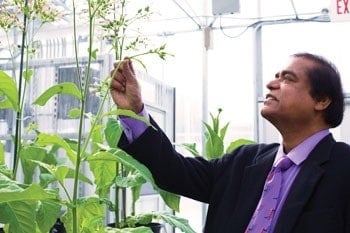Pulmonary hypertension is a rare but devastating disease that occurs when the arteries feeding the lungs narrow, making the right side of the heart work harder to pump blood to the lungs. Over time, the heart weakens, leading to heart failure.
The disease can affect the young as well as the old. There is no cure, and the most successful treatments currently available cost tens of thousands of dollars.
Research by Penn scientists, however, aims to change that.
Henry Daniell, director of translational research and a professor of biochemistry and pathology at theSchool of Dental Medicine, worked with colleagues from Penn and the University of Florida to use his plant-based drug delivery system to help regulate blood pressure in rats with a form of pulmonary hypertension, or PH.
The researchers focused on the hormones ACE 2 and Ang-(1-7), which maintain normal cardiopulmonary pressure and balance out the blood pressure-raising effects of another hormone, angiotensin II. Daniell and his team introduced the ACE 2 and Ang-(1-7) proteins into chloroplasts of tobacco plants. These proteins were fused to another protein that binds to intestinal cells, enabling the hormones to cross the intestinal wall and enter the bloodstream.
After selecting the plants that produced the new proteins, the researchers grew them and then harvested, freeze-dried, and encapsulated their leaves. The scientists fed the capsules to rats that were bred so that the researchers could experimentally induce them to develop PH.
Daniell and colleagues found that feeding the capsules to rats at the same time that PH was induced could prevent rats from developing PH and its accompany cardiac symptoms. In rats that had established cases of PH, the capsules reduced pulmonary pressure by up to 20 percent after two weeks of treatment, and 32 percent after four weeks.
Although large proteins, such as the ACE 2 and Ang-(1-7) hormones, are typically unstable and dissipate quickly in the body, the researchers found that delivering them in the plants allowed hormone levels to be maintained for four to five hours.
The study suggests a strategy for addressing a difficult-to-treat disease at its source, but also offers a large cost advantage over injectable drugs.
“If you’re making a drug based on a humongous protein, the cost is going to be high because of all the challenges involved in drug delivery,” Daniell says. “Our approach, because it is shelf-stable and involves capsules that people can take without going to the hospital, has the potential to offer a much more affordable alternative.”


